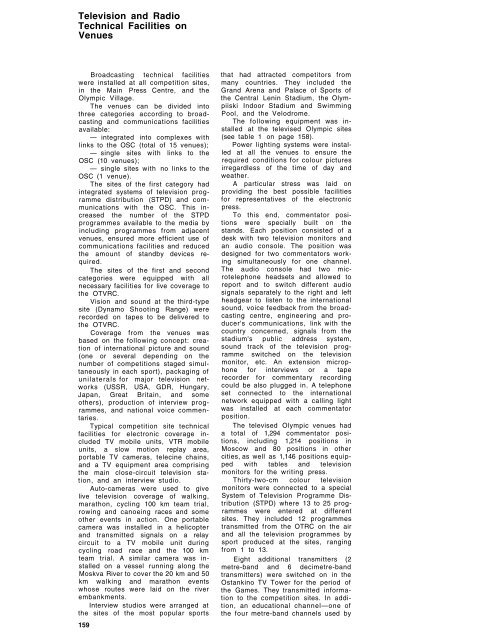or1980v2pt1
or1980v2pt1
or1980v2pt1
Create successful ePaper yourself
Turn your PDF publications into a flip-book with our unique Google optimized e-Paper software.
Television and Radio<br />
Technical Facilities on<br />
Venues<br />
Broadcasting technical facilities<br />
were installed at all competition sites,<br />
in the Main Press Centre, and the<br />
Olympic Village.<br />
The venues can be divided into<br />
three categories according to broadcasting<br />
and communications facilities<br />
available:<br />
— integrated into complexes with<br />
links to the OSC (total of 15 venues);<br />
— single sites with links to the<br />
OSC (10 venues);<br />
— single sites with no links to the<br />
OSC (1 venue).<br />
The sites of the first category had<br />
integrated systems of television programme<br />
distribution (STPD) and communications<br />
with the OSC. This increased<br />
the number of the STPD<br />
programmes available to the media by<br />
including programmes from adjacent<br />
venues, ensured more efficient use of<br />
communications facilities and reduced<br />
the amount of standby devices required.<br />
The sites of the first and second<br />
categories were equipped with all<br />
necessary facilities for live coverage to<br />
the OTVRC.<br />
Vision and sound at the third-type<br />
site (Dynamo Shooting Range) were<br />
recorded on tapes to be delivered to<br />
the OTVRC.<br />
Coverage from the venues was<br />
based on the following concept: creation<br />
of international picture and sound<br />
(one or several depending on the<br />
number of competitions staged simultaneously<br />
in each sport), packaging of<br />
unilaterals for major television networks<br />
(USSR, USA, GDR, Hungary,<br />
Japan, Great Britain, and some<br />
others), production of interview programmes,<br />
and national voice commentaries.<br />
Typical competition site technical<br />
facilities for electronic coverage included<br />
TV mobile units, VTR mobile<br />
units, a slow motion replay area,<br />
portable TV cameras, telecine chains,<br />
and a TV equipment area comprising<br />
the main close-circuit television station,<br />
and an interview studio.<br />
Auto-cameras were used to give<br />
live television coverage of walking,<br />
marathon, cycling 100 km team trial,<br />
rowing and canoeing races and some<br />
other events in action. One portable<br />
camera was installed in a helicopter<br />
and transmitted signals on a relay<br />
circuit to a TV mobile unit during<br />
cycling road race and the 100 km<br />
team trial. A similar camera was installed<br />
on a vessel running along the<br />
Moskva River to cover the 20 km and 50<br />
km walking and marathon events<br />
whose routes were laid on the river<br />
embankments.<br />
Interview studios were arranged at<br />
the sites of the most popular sports<br />
159<br />
that had attracted competitors from<br />
many countries. They included the<br />
Grand Arena and Palace of Sports of<br />
the Central Lenin Stadium, the Olympiiski<br />
Indoor Stadium and Swimming<br />
Pool, and the Velodrome.<br />
The following equipment was installed<br />
at the televised Olympic sites<br />
(see table 1 on page 158).<br />
Power lighting systems were installed<br />
at all the venues to ensure the<br />
required conditions for colour pictures<br />
irregardless of the time of day and<br />
weather.<br />
A particular stress was laid on<br />
providing the best possible facilities<br />
for representatives of the electronic<br />
press.<br />
To this end, commentator positions<br />
were specially built on the<br />
stands. Each position consisted of a<br />
desk with two television monitors and<br />
an audio console. The position was<br />
designed for two commentators working<br />
simultaneously for one channel.<br />
The audio console had two microtelephone<br />
headsets and allowed to<br />
report and to switch different audio<br />
signals separately to the right and left<br />
headgear to listen to the international<br />
sound, voice feedback from the broadcasting<br />
centre, engineering and producer's<br />
communications, link with the<br />
country concerned, signals from the<br />
stadium's public address system,<br />
sound track of the television programme<br />
switched on the television<br />
monitor, etc. An extension microphone<br />
for interviews or a tape<br />
recorder for commentary recording<br />
could be also plugged in. A telephone<br />
set connected to the international<br />
network equipped with a calling light<br />
was installed at each commentator<br />
position.<br />
The televised Olympic venues had<br />
a total of 1,294 commentator positions,<br />
including 1,214 positions in<br />
Moscow and 80 positions in other<br />
cities, as well as 1,146 positions equipped<br />
with tables and television<br />
monitors for the writing press.<br />
Thirty-two-cm colour television<br />
monitors were connected to a special<br />
System of Television Programme Distribution<br />
(STPD) where 13 to 25 programmes<br />
were entered at different<br />
sites. They included 12 programmes<br />
transmitted from the OTRC on the air<br />
and all the television programmes by<br />
sport produced at the sites, ranging<br />
from 1 to 13.<br />
Eight additional transmitters (2<br />
metre-band and 6 decimetre-band<br />
transmitters) were switched on in the<br />
Ostankino TV Tower for the period of<br />
the Games. They transmitted information<br />
to the competition sites. In addition,<br />
an educational channel—one of<br />
the four metre-band channels used by


